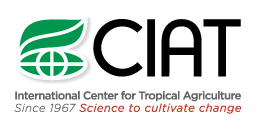Breaking the bottlenecks to bean seed systems in Africa
With more than 350 partners in 30 countries, the Pan-Africa Bean Research Alliance (PABRA) works with the whole range of actors involved in producing beans – one of the most actively traded commodities in Africa – achieve the shared aim of breaking bottlenecks in seed systems.
Despite substantial investments in crop breeding, bottlenecks in accessing quality bean seed in Africa persist. CIAT, National Bean Research Programs members of PABRA, and the Syngenta Foundation for Sustainable Agriculture (SFSA) are working together and with other partners to meet the challenge.
White gold in Ethiopia
In his hands, Abdul Kadir holds a milky white bean. Ten years ago, he says, it was a rare thing in Ethiopia. But today, it enables him to buy cattle, send his children to school, and build a house.
Kadir is one of 2.5 million smallholder farmers who rely on white pea beans for an income. He also multiplies bean seeds to sell to other farmers. Initially, he got the seeds on loan from Ethiopia’s National Bean Research Program: Now he invests in them himself.

Demand for the quality white pea beans is higher than ever, so maintaining quality is key. In the last decade, the number of organizations multiplying improved beans has nearly tripled from 15 to 43.
Mekonnen KebedePABRA has linked the efforts of people like Kadir and Kedebe across Africa.
Through the PABRA network, seed multiplication companies get high-quality, high-yielding bean varieties without having to invest in costly breeding programs. And national bean programs can support seed producers by multiplying seed on a scale that would not otherwise be possible. Farmers get both higher quality beans and better access to them.
This collaborative approach is being repeated across other PABRA member countries.
We introduce germplasm from CIAT and develop and test the beans in our own breeding program. Each region has constraining factors, like diseases, insect pests, drought, low soil fertility, and soil acidity.
Kidane Tusma














Climbing to new heights
Today, Rwanda has one of the best seed breeding programs and strongest community-based systems in Africa. More than 30 high-performance bean varieties were released in the last decades through PABRA.
Better bean varieties are of vital importance in Rwanda where farm sizes are declining, as population increases: By 2100, the country’s population of 12 million is projected to reach more than 40 million.
Improved climbing beans, which produce more food on less land, are currently planted on more than half the country’s bean production area, representing a 45% increase since 1985. In the last decade, the country has been transformed from a net importer to an exporter (with exports valued at US$12-20 million) and yields have increased from 0.7 to 1.1 tons per hectare.
Innovation and collaboration through the PABRA network have led to solutions tailored to the smallholder client, including smaller bean seed packs (containing 1 and 5 kilograms) – designed for farmers who grow the crop on plots of less than 0.2 hectares and cannot afford larger packs.
Innovation and collaboration through the PABRA network have led to solutions tailored to the smallholder client, including smaller bean seed packs.
Keeping beans on the menu
Farmers and researchers can’t rest on their laurels. Variety development is never finished.
“We need to stay ahead of threats like climate change and emerging insect pests and diseases – to continue putting breakfast on the table,” says Kidane.
In 2014, a drought – the worst to hit the Ethiopia’s bean-producing areas in 10 years, researchers report – cut yields by 30 percent, hurting farmer livelihoods.
To help ensure farmers are able to put food on the table, CIAT deployed the latest drought-resilient bean varieties to Ethiopia, to be tested and evaluated by researchers at the Ethiopian Institute of Agricultural Research (EIAR).
Drought- and heat-tolerant varieties can help farmers cope with a changing climate while varieties with higher micronutrient levels have good potential to enhance nutrition. Seed thus provides a way to reach multiple goals in one fell swoop: better productivity, nutrition, resilience and even income.
Thirty new bean varieties bred to beat baking climate http://t.co/8Bgd3sSiIZ
— Reuters Science News (@ReutersScience) March 25, 2015
Reaching further
Decades of national and international investment have led to the on-going development of hundreds of modern crop varieties. The challenge, however, is to ensure that better seed reaches smallholder farmers — including those in the most remote communities.
- Only 3-5% of farmers have access to certified seed in some regions of Africa.
- Two-thirds of beans and other legumes purchased by smallholders are from informal markets.
%
of beans and other legumes purchased by smallholders are from informal markets
Bean farmers are not well served, and getting seeds out to them is a challenge in many parts of the world. Bean seed systems are not well developed compared to other crops – farmers get bean seed in a haphazard way, through NGOs or seed aid or neighbors – but not through sustainable channels.
Louise SperlingNow is the time for an equally determined effort to bring quality seed of these varieties within the reach of more rural households. PABRA members continue working together and in partnership with farmers to breed, multiply, supply, and deliver quality bean seed across Africa.
PABRA members continue working together and in partnership with farmers to breed, multiply, supply, and deliver quality bean seed across Africa.
















